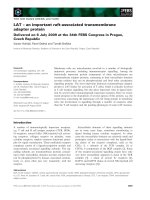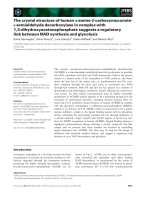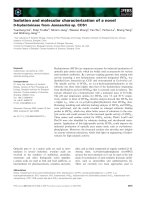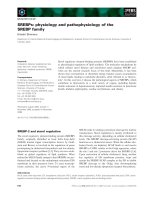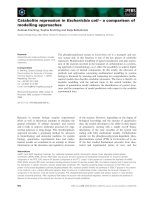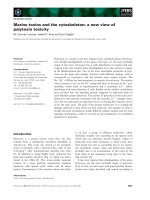Tài liệu Báo cáo khoa học: "Using an Annotated Corpus as a Stochastic Grammar" ppt
Bạn đang xem bản rút gọn của tài liệu. Xem và tải ngay bản đầy đủ của tài liệu tại đây (572.53 KB, 8 trang )
Using an Annotated Corpus as a Stochastic Grammar
Rens Bod
Department of Computational Linguistics
University of Amsterdam
Spuistraat 134
NL-1012 VB Amsterdam
Abstract
In Data Oriented Parsing (DOP), an annotated
corpus is used as a stochastic grammar. An
input string is parsed by combining subtrees
from the corpus. As a consequence, one parse
tree can usually be generated by several
derivations that involve different subtrces. This
leads
to
a statistics where the probability of a
parse is equal to the sum of the probabilities of
all its derivations. In (Scha, 1990) an informal
introduction to DOP is given, while (Bed,
1992a) provides a formalization of the theory.
In this paper we compare DOP with other
stochastic grammars in the context of Formal
Language Theory. It it proved that it is not
possible to create for every DOP-model a
strongly equivalent stochastic CFG which also
assigns the same probabilities to the parses.
We show that the maximum probability parse
can be estimated in polynomial time by
applying Monte Carlo techniques. The model
was tested on a set of hand-parsed strings from
the Air Travel Information System (ATIS)
spoken language corpus. Preliminary
experiments yield 96% test set parsing
accuracy.
1 Motivation
As soon as a formal grammar characterizes a non-
trivial part of a natural language, .almost every input
string of reasonable length gets an unmanageably large
number of different analyses. Since most of these
analyses are not perceived as plausible by a human
language user, there is a need for distinguishing the
plausible parse(s) of an input string from the
implausible ones. In stochastic language processing, it
is assumed that the most plausible parse of an input
string is its most probable parse. Most instantiations
of this idea estimate the probability of a parse by
assigning application probabilities to context free
rewrite roles (Jelinek, 1990), or by assigning
combination probabilities to elementary structures
(Resnik, 1992; Schabes, 1992).
There is some agreement now that context free rewrite
rules are not adequate for estimating the probability of
a parse, since they cannot capture syntactie/lexical
context, and hence cannot describe how the probability
of syntactic structures or lexical items depends on that
context. In stochastic tree-adjoining grammar
(Schabes, 1992), this lack of context-sensitivity is
overcome by assigning probabilities to larger
structural units. However, it is not always evident
which structures should be considered as elementary
structures. In (Schabes, 1992) it is proposed to infer a
stochastic TAG from a large training corpus using an
inside-outside-like iterative algorithm.
Data Oriented Parsing fDOP) (Scha, 1990; Bod,
1992a), distinguishes itself from other statistical
approaches in that it omits the step of inferring a
grammar from a corpus. Instead, an annotated corpus
is directly used as a stochastic grammar. An input
string is parsed by combining subtrees from the
corpus. In this view, every subtree can be considered
as an elementary structure. As a consequence, one
parse tree can usually be generated by several
derivations that involve different subtrees. This leads
to a statistics where the probability of a parse is equal
to the sum of the probabilities of all its derivations. It
is hoped that this approach can accommodate all
statistical properties of a language corpus.
37
Let
us illustrate DOP with an extremely simple
example. Suppose that a cotpns consists of only two
trees:
A
NP VP NP VP
Suppose that our combination operation (indicated
with o) consists of substituting a subtree on the
leftmost identically labeled leaf node of another
subtree. Then the sentence
Mary likes Susan can be
parsed as an S by combining the following subtre~
from the corpus.
S o NP o NP
/k
v NP
l
NP VP
I A
Mary V NP
is!
But the same parse tree can also be derived by
combining other subirees, for instance:
S o NP o V
/k
v ~
I
Sm
S o NP o VP o NP
/"-,.w sI, L
,,L
Thus, a parse can have several derivations involving
different subtrees. These derivations have different
probabilities. Using the corpus as our stochastic
grammar, we estimate the probabifity of substituting a
certain subtree on a specific node as the probability of
selecting this subtree among all subtrees in the corpus
that could be substituted on that node. The probability
of a derivation can be computed as the product of the
probabilities of the subtre~ that are combined. For the
example derivations above, this yields:
P(Ist example) = 1/20 • 1/4 • 1/4
P(2nd example) = 1/20 • 1/4 • 1/2
P(3rd example) = 2/20 • 1/4 • 1/8 • 1/4
= 1/320
= 1/160
= 1/1280
This example illustrates that a stntigtical language
model which defines probabilities over parses by
taking into ac~unt only one ,derivation, does not
accommodate all statistical properties of a language
corpus. Instead, we will defme the probability of a
parse as the sum of the probabilities of all its
derivations. Finally, the probability of a string is
equal to the sum of the probabilities of all its parses.
We will show ,hat conventional parsing techniques
can be applied to DOP, but that this becomes very
inefficient, since the number of derivations of a parse
grows exponentially with the length of the input
suing. However, we will show that DOP can be
parsed in polynomial time by using Monte Carlo
techniques.
An important advantage of using a corpus for
probability calculation, is that no tr0jning of
parameters is needed, as is the case for other stochastic
grammars (Jelinek et al., 1990; Pereira and Schabes,
1992; Schabes, 1992). Secondly, since we take into
account all derivations of a parse, no relationship that
might possibly be of statistical interest is ignored.
38
2 The Model
As might be clear by now, a IX)P-model is
characterized by a corpus of tree structures, together
with a set of operations that combine subtrees from
the corpus into new trees. In this section we explain
more precisely what we mean by subtree, operations
etc., in order to arrive at definitions of a parse and the
probability of a parse with respect to a corpus. For a
treatment of DOP in more formal terms we refer to
(Bod, 1992a).
2.1 Subtree
A subtree
of a tree T is a connected subgraph S of T
such that for every node in S holds that if it has
daughter nodes, then these are equal to the daughter
nodes of the corresponding node in T. It is trivial to
see that a subuee is also a tree. In the following
example T 1 and T2 are subtrees of T, whereas T 3
isn't.
Y
S
I /x
John V NP
~s Tavp T3s
NP VP V NP
A I I I
V NP likes John NP
The general definition above also includes subUees
consisting of one node. Since such subtrees do not
contribute to the parsing process, we exclude these
pathological cases and consider as the set of sublrees
the non-trivial ones consisting of more than one node.
We shall use the following notation to indicate that a
tree t is a non-trivial subtree of a tree in a corpus C:
t e C =oer 3 T 6 C: t is a non-trivial subtree of T
2.2
Operations
In this article we will limit ourselves to the basic
operation of
substitution.
Other possible operations
are left to future research. If t and u are trees, such that
the leftmost non-terminal leaf of t
is equal to the
root
of u, then
tou is the tree that
results from substituting
this non-terminal leaf in t by tree u. The partial
function
o is called substitution.
We will write
(tou)ov as touov,
and in general
( ((tlot2)ot3)o )otn as
tlot2ot3o otn. The
restriction
le£tmost in the
defin-
ition is motivated by the fact that it eliminates
different derivations consisting of the same subtrees.
2.3 Parse
Tree Tis a
parse
of input string s with respect to a
corpus C, iffthe
yieldof
Tis equal to s and there are
subtrees
tI, ,tn e C,
such that T
tlO , otn. The set
of parses of s with respect to C, is thus given by:
parses(s,C) =
{T I yield(T) = s A 3 tl tne C: T = tlo otn}
The definition correctly includes the trivial case of a
subtree from the corpus whose
yield
is equal to the
complete input string.
2.4 Derivation
A derivation
of a parse T with respect to a corpus C,
is a tuple of subtrees
(tl ta)
such that
tl tne C
and tlo otn
= T. The set of derivations of T with
respect to C, is thus given by:
Derivations(T,C) =
{(tl t~) I tl tne C A tlO otn= T}
2.5 Probability
2.5.1 Subtree
Given a subtree
tl
e C, a function root that yields the
root of a tree, and a node labeled X, the conditional
probability
P(t=tl / root(t)=X)
denotes the probability
that t/ is substituted on X. If
root(Q)¢ X, tins
probability is 0. If
root(t1) = X,
this probability can
be estimated as the ratio between the number of
occurrences of
tl
in C and the total number of
occurrences of subtrees t' in C for which holds that
root(f) = X.
Evidently,
Zi P(t=-ti I root(O=X) = 1
holds.
2.5.2 Derivation
The probability of a derivation
(tl tn) is equal to
the probability that the subtrees
tl tn are
combined.
This probability can be computed as the product of the
39
conditional probabilities of the subtrees
tl t o. Let
lnI(x) be the
leflmost non-terminal leaf of tree x, then:
P(t=tllrOOt(t) S) • I-li-_.2ton P(t=ti I root(t) = lnl(ti.l))
2.5.3
Parse
The probability of a parse is equal to the probability
that any of its derivations occurs. Since the
derivations are mutually exclusive, the probability of a
parse T is the sum of the probabilities of all its
derivations. Let
Detivations(T,C) = [ d I dn},
then:
P(T) = ~,i P(di). The
conditional probability of a
parse T given input siring s, can be computed as the
ratio between the probability of T and the sum of the
probabilities of all parses of s.
2.5.4
String
The
probability of
a string is equal to the probability
that any of its parses occurs. Since the parses are
mutually exclusive, the probability of a string s can be
computed as the sum of the probabilities of all its
parses. Let
Parse.s(s,C) = {T I Tn},
then:
P(s) =
2~ i
P(T/). It
can be shown that
~'i
P(si) = 1 holds.
3 Superstrong Equivalence
There is an important question as to whether it is
possible to create for every DOP-model a strongly
equivalent stochastic CFG which also assigns the
same probabifities to the parses. In order to discuss
this question, we introduce the notion of
superstrong
equivalence.
Two stochastic grammars are called
superstrongly equivalent, if they are strongly
equivalent (i.e. they generate the same strings with the
same trees) and they generate the same probability
distribution over the trees.
The question as to whether for every DOP-model there
exists a strongly equivalent stochastic CFG, is rather
trivial, since every subtree can be decomposed into
rewrite rules describing exactly every level of
constituent structure of that subtree. The question as
to whether for every DOP-model there exists a
supets¢ongly equivalent stochastic CFG, can also be
answered without too much difficulty. We shall give a
counter-example, showing that there exists a DOP-
model for which there is no superstrongly equivalent
stochastic CFG.
Proposition
It is not the case
that/'or every DOP-
model
there exists a superstrongly equivalent
stochastic CFG.
Proof
Consider the following DOP-model, consisting of a
corpus with just one tree.
S b
I
a
This corpus contains three subtrees, namely
S S
S b
I
a
tl
S
I
S b a
t2 t3
The conditional probabilities of the subtrees are:
P(t=-t I I root(t)=S) = 1/3, P(t=t 2 1 root(t)=S) = 1/3,
P(~t3 1 root(t)=S) = 1/3.
Thus,
Z, i P(t=ti fi'oot(t)=S) =
1 holds. The language generated by this model is
{ab*}. Let us consider the probabilities of the parses
of the strings a and ab. The parse of siring a can be
generated by exactly one derivation: by applying
subtree
t3.
The probability of this parse is hence equal
to 1/3. The parse of ab can be generated by two
derivations: by applying subtree
tl, or
by combining
subUees
t2 and t3. The
probability of this parse is
equal to the sum of the probabilities of its two
derivations, which is equal to
P(t= tl~OOt(t)=S) +
P(~t2~oot(t)=S) * P(t=t31root(t)=S)= 1/3 + 1/3,1/3
=4/9.
If we now want to construct a superstrongly equivalent
stochastic CFG, it should assign the same
probabilities to these parses. We will show that this is
impossible. A CFG which is strongly equivalent with
the DOP-model above, should contain the following
rewrite rules.
S ~ Sb (1)
S , a (2)
There may be other rules as well, but they should not
modify the language or slructures generated by the
CFG above. Thus, the rewrite rule S ~ A may be
40
added to the rules, as well as A ~ B, whereas the
rewrite rule
S -o ab
may not be added.
Our problem is now whether we can assign
probabilities to these rules such that the probability of
the parse of a equals
1/3, and the
probability of the
parse of ab equals 4/9. The parse of a can exhaustively
be generated by applying rule
(2),
while the parse of
ab can
exhaustively be generated by applying rules
(1)
and (2).
Thus the following should hold:
P(2) = 1/3
P(1)*P(2) = 4/9
This implies that
t)(I),1/3 = 4/9,
thus
P(1) = 4/9 • 3
= 4/3.
This means that the probability of rule
(1)
should be larger than I, which is not allowed. Thus,
we have proved that not for every DOP-model there
exists a superstrongly equivalent stochastic CFG. In
(Bod, 1992b) superstrong equivalence relations
between other stochastic grammars are studied.
4 Monte Carlo Parsing
It is easy to show that an input string can be parsed
with conventional parsing techniques, by applying
subtrees instead of rules to the input string (Bod,
1992a). Every subtree t can be seen as a production
rule
toot(O , ~
where the non-terminals of the yield
of the right hand side constitute the symbols to which
new rules/subtrees are applied. Given a polynomial
time parsing algoritiun, a derivation of the input
string, and hence a parse, can be calculated in
polynomial time. But if we calculate the probability
of a parse by exhaustively calculating all its
derivations, the time complexity becomes exponential,
since the number of derivations of a parse of an input
string grows exponentially with the length of the
input string.
Nevertheless, by applying
Monte Carlo techniques
Crlammersley and Handscomb, 1964), we can estimate
the probability of a parse and make its error arbitrarily
small in polynomial time. The essence of Monte
Carlo is very simple: it estimates a probability
distribution of events by taking random samples. The
larger the samples we take, the higher the reliability.
For DOP this means that, instead of exhaustively
calculating all parses with all their derivations, we
randomly calculate N parses of an input string (by
taking random samples from the subtrees that can be
substituted on a specific node in the parsing process).
The estimated probability of a certain parse given the
input string, is then equal to the number of times that
parse occurred normalized with respect to N. We can
estimate a probability as accurately as we want by
choosing Nas large as we want, since according to the
Strong Law of Large Numbers the estimated
probability converges to the actual probability. From a
classical result of probability theory (Chebyshev's
inequality) it follows that the time complexity of
achieving a maximum error e is given by
O(e'2).
Thus
the error of probability estimation can be made
arbitrarily small in polynomial time - provided that
the parsing algorithm is not worse than polynomial.
Obviously, probable parses of an input string are more
likely to be generated than improbable ones. Thus, in
order to estimate the maximum probability parse,
it
suffices to sample until stability in the top of the
parse distribution occurs. The parse which is generated
most often is then the maximum probability parse.
We now show that the probability that a certain parse
is generated by Monte Carlo, is exactly the probability
of that parse according to the DOP-model. First, the
probability that a subtree t e C is sampled at a certain
point in the parsing process (where a non-terminal X
is to be substituted) is equal to
P( t I root(t) = X ).
Secondly, the probability that a certain sequence
tl tn
of subtrees that constitutes a derivation of a
parse T, is sampled, is equal to the product of the
conditional probabilities of these subtrees. Finally, the
probability that any sequence of subtrees that
constitutes a derivation of a certain parse T, is
sampled, is equal to the sum of the probabilities that
these derivations are sampled. This is the probability
that a certain parse T is sampled, which is equivalent
to the probability of T according to the DOP-model.
We shall call a parser which applies this Monte Carlo
technique, a
Monte Carlo parser.
With respect to the
theory of computation, a Monte Carlo parser is a
probabilistic algorithm
which belongs to the class of
Bounded error Probabilistic Polynomial time
(BPP)
algorithms. BPP-problems are characterized by the
following: it may take exponential time to solve them
exactly, but there exists an estimation algorithm with
a probability of error that becomes arbitrarily small in
polynomial time.
Experiments on the ATIS corpus
For our experiments we used part-of-speech sequences
of spoken-language transcriptions from the Air Travel
Information System (ATIS) corpus (Hemphill et al.,
1990), with the labeled-bracketings of those sequences
in the Penn Treebank (Marcus, 1991). The 750
41
labeled-bracketings were divided at random into a
DOP-corpus of 675 trees and a test set of 75 part-of-
speech sequences. The following tree is an example
from the DOP-corpns, where for reasons of readability
the lexical items are added to the part-of-speech tags.
( (S (NP *)
fVP (VB Show)
(NP (PP me))
(NP (NP (PDT all))
(DT the) (JJ nonstop) (NNS flights)
(Pp (PP ON from)
(NP (NP Dallas)))
(PP (TO to)
(NP (NP Denver))))
(ADJP (JJ early)
(PP (IN in)
(NP (DT the)
(NN morning)))))) .)
As a measure for pars/n#
accuracy
we took the
percentage of the test sentences for which the
maximum probability parse derived by the Monte
Carlo parser (for a sample size N) is identical to the
Treebankparse.
It is one of the most essential features of the DOP
approach, that arbitrarily large subtrees are taken into
consideration. In order to test the usefulness of this
feature, we performed different experiments
constraining the
depth
of the subtrees. The depth of a
tree is defmed as the length of its longest path. The
following table shows the results of seven
experiments. The accuracy refers to the parsing
accuracy at sample size
N=
I00, and is rounded off to
the nearest integer.
depth accuracy
ii
~2 87%
~3 92%
.~4 93%
.~ 93%
~6 95%
~7 95%
unbounded 96%
Parsing accuracy for the ATIS corpus, sample size N= I00.
The table shows that there is a relatively rapid inc~'~ase
in parsing accuracy when enlarging the maximum
depth of the subUees to 3. The accuracy keeps
increasing, at a slower rate, when the depth is enlarged
further. The highest accuracy is obtained by using all
subtrees from the corpus: 72 out of the 75 sentences
from the test set are parsed correctly.
In the following figure, parsing accuracy is plotted
against the sample size Nfor three of our experiments:
the experiments where the depth of the subtrees is
constrained to 2 and 3, and the experiment where the
depth is unconswained. (The maximum depth in the
ATIS corpus is 13.)
75
I I I
sample size N
100
Parsing accuracy for the ATIS corpus, with depth < 2, with
depth < 3 and with unbounded depth.
In (Pereira and Schabes, 1992), 90.36% bracketing
accuracy was reported using a stochastic CFG trained
on bracketings from the ATIS corpus. Though we
cannot make a direct c¢~parison, our pilot experiment
suggests that our model may have better performance
than a stochastic CFG. However, there is still an error
rate of 4%. Although there is no reason to expect
100% accuracy in the absence of any semantic or
pragmatic analysis, it seems that the accuracy might
be further improved. Three limitations of the current
experiments are worth mentioning,
Fn~t, the Treebank annotations are not rich enough.
Although the Treebank uses a relatively rich part-of-
speech system (48 terminal symbols), there are only
15 non-terwinal symbols. Especially the internal
su~cmre of noun phrases is very poor. Semantic
annotations are completely absent.
42
Secondly, it could be that subtrees which occur only
once in the corpus, give bad estimations of their actual
probabilities. The question as to whether reestimation
techniques would further improve the accuracy, must
be considered in future research.
Thirdly, it could be that our corpus is not large
enough. This brings us to the question as to how
much parsing accuracy depends on the size of the
corpus. For studying this question, we performed
additional experiments with different corpus sizes.
Starting with a corpus of only 50 parse trees
(randomly chosen from the initial DOP-corpus of 675
trees), we increased its size with intervals of 50. As
our test set, we took the same 75 p-o-s sequences as
used in the previous experiments. In the next figure
the parsing accuracy, for sample size N = 100, is
plotted against the corpus size, using all corpus
subtrees.
100
75.
25.
0
0
0 0
0
0 0
O
O
0 O
O
i~o ~ 3~o & 5~o &
corpus size
Parsing accuracy for the ATIS corpus, with unbounded
depth.
675
The figure shows the increase in parsing accuracy. For
a corpus size of 450 trees, the accuracy reaches already
88%. After this, the growth decreases, but the accuracy
is still growing at corpus size 675. Thus, we would
expect a higher accuracy if the corpus is further
enlarged.
6 Conclusions and Future Research
We have presented a language model that uses an
annotated corpus as a stochastic grammar. We
restricted ourselves to substitution as the only
combination operation between corpus subtrees. A
statistical parsing theory was developed, where one
parse can be generated by different derivations, and
where the probability of a parse is computed as the
sum of the probabilities of all its derivations. It was
shown that our model cannot always be described by a
stochastic CFG. It turned out that the maximum
probability parse can be estimated as accurately as
desired in polynomial time by using Monte Carlo
techniques. The method has been succesfully tested on
a set of part-of-speech sequences derived from the
ATIS corpus. It turned out that parsing accuracy
improved if larger subtrees were used.
We would like to extend our experiments to larger
corpora, like the Wall Street Journal corpus. This
might raise computational problems, since the number
of subtrees becomes extremely large. Furthermore, in
order to tackle the problem of data sparseness, the
possibility of abstracting from corpus data should be
included, but statistical models of abstractions of
features and categories are not yet available.
Acknowledgements
The author is very much indebted to Remko Scha for
many valuable comments on earlier versions of this
paper. The author is also grateful to Mitch Marcus for
supplying the ATIS corpus.
References
R. Bod, 1992a. "A Computational Model of
Language Performance: Data Oriented Parsing",
Proceedings COLING~92,
Nantes.
R. Bod, 1992b. "Mathematical Properties of the Data
Oriented Parsing Model", paper presented at the Th/rd
Meeting on Mathematics of Language OVIOL3),
Austin, Texas.
J.M.
Hammersley and D.C. Handscomb, 1964.
Monte
Carlo Methods,
Chapman and Hall, London.
C.T. Hemphill, J.J.
Godfrey
and G.R. Doddington,
1990. "The ATIS spoken language systems
pilot
corpus".
DARPA Speech and Natural Language
Workshop,
Hidden Valley, Morgan Kaufmann.
F. Jelinek, J.D. Lafferty and R.L. Mercer, 1990.
Basic
Methods of Probabilistic Context Free Grammars,
Technical Report IBM RC 16374 (#72684), Yorktown
Heights.
43
M. Marcus, 1991. "Very Large Annotated Database of
America~ English".
DARPA Speech and Naawal
Language Workshop, ~ Grove, Morgan
Kaufmarm.
F. Pereira and Y. Schabes, 1992. "Inside-Outside
Reestimation from Partially Bracketed Corlmra',
Proceedings ACY., 92,
Newark.
P. Resnik, 1992. "Probabilistic Tree-Adjoining
Grammar as a Framework for Statistical Natural
Language Processing",
Proceedings COLING92,
Nantes.
R. Scha, 1990. "Language Theory and Language
Technology; Competence and Performance" (in
Dutch), in Q.A.M. de Kort & G.L.J. Leordam (eds.),
Computeltoepassingen in de Needanclistiek,
Almere:
Landelijkc Vereniging van Neerlandici (LVVN-
jaatbock).
Y. Schabes, 1992. "Stochastic Lexicalized Tree-
Adjoining Grammars",
Proceedings COLING'92,
Nantes.
44




